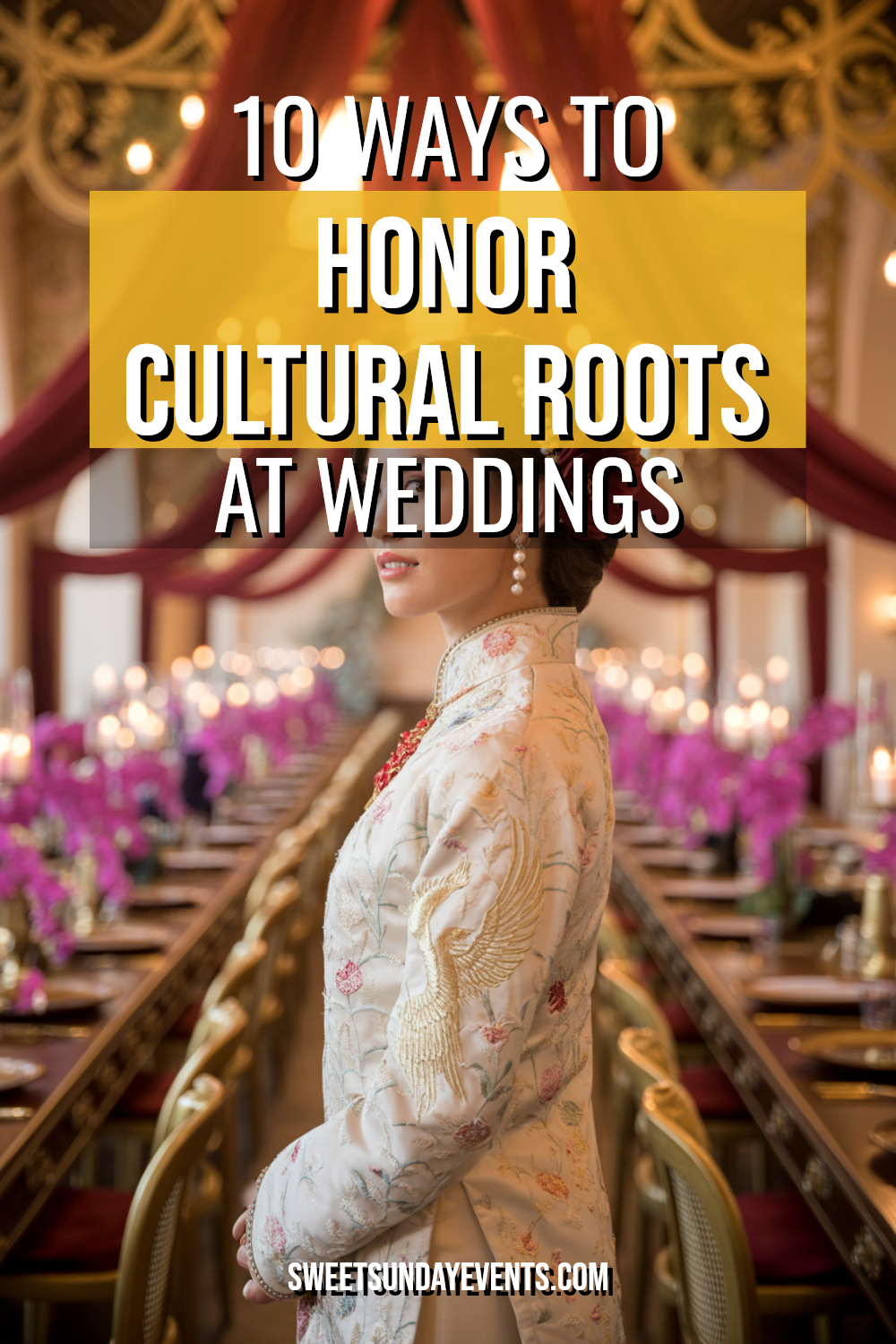Your wedding day should tell your story—not just the love story between you two, but the rich tapestry of traditions, customs, and heritage that shaped who you are.
Blending cultural elements into your celebration creates depth, meaning, and moments that’ll have your grandmother dabbing her eyes with pride.
1. Incorporate Traditional Attire
Wedding dress shopping becomes infinitely more interesting when you expand beyond the white gown aisle. Consider wearing your grandmother’s sari for part of the ceremony, or having your groom don his family’s traditional kilt alongside the modern tuxedo.
Many couples choose to have multiple outfit changes throughout their wedding day. Start with traditional attire for a cultural ceremony, then switch to Western wear for the reception—or vice versa.
This gives you the best of both worlds and creates natural photo opportunities that showcase your heritage.
Don’t forget about your wedding party either. Bridesmaids in coordinating saris or groomsmen in matching dashikis can create stunning visual unity while honoring your roots.
Just make sure everyone’s comfortable with what they’re wearing—nobody wants to spend the reception readjusting unfamiliar garments.
2. Design Meaningful Ceremony Rituals
Every culture has beautiful wedding traditions that go far deeper than “something old, something new.” Research your family’s customs and choose the ones that resonate with your values as a couple.
The handfasting ceremony from Celtic tradition literally gave us the phrase “tying the knot.” Jewish couples break glass to symbolize the fragility of human relationships and the destruction of the Temple.
Hindu ceremonies include seven circles around a sacred fire, each representing a different vow.
You can also create hybrid ceremonies that blend multiple traditions. One couple I worked with combined a Christian exchange of rings with a Chinese tea ceremony, creating a beautiful flow that honored both families.
The key is explaining these rituals to your guests beforehand so everyone understands the significance.
3. Curate Heritage-Inspired Music
Your playlist shouldn’t just be Top 40 hits and the Electric Slide. Weaving traditional music throughout your celebration connects guests to your cultural story and gets everyone moving to rhythms they might not hear every day.
Consider hiring musicians who specialize in your cultural music—mariachi bands, Celtic harpers, or dhol players can transform the entire atmosphere of your event.
Live music always hits differently than a DJ spinning tracks, especially when it’s music that carries generations of meaning.
Balance is crucial here. You want to honor your heritage without alienating guests who might not be familiar with the music. Mix traditional songs with contemporary versions or fusion pieces that bridge the gap between old and new.
4. Serve Authentic Cultural Cuisine
Forget the standard wedding chicken or fish dilemma. Your wedding menu is a perfect opportunity to introduce guests to the flavors that defined your childhood and continue to bring your family together.
Work with caterers who understand your cultural cuisine, or better yet, find vendors from your community who specialize in authentic preparation.
There’s a world of difference between “fusion” food and dishes prepared by someone who learned the recipes from their grandmother.
Consider creating a menu that tells a story. Start with appetizers from one culture, move to entrees from another, and finish with desserts that represent your combined heritage.
Include small cards explaining the significance of certain dishes—guests love learning while they eat.
5. Embrace Traditional Wedding Favors
Wedding favors often end up forgotten in glove compartments, but cultural favors carry meaning that guests will actually treasure. These small tokens can educate your guests about your heritage while giving them something genuinely special to take home.
Think beyond the typical Jordan almonds or personalized candles. Turkish couples often give evil eye charms for protection. Indian weddings might feature small potted plants or spices.
Mexican celebrations could include handmade soaps or artisanal chocolates from local vendors.
The best cultural favors tell a story. Include a small card explaining the tradition behind your chosen favor. When guests understand that they’re receiving a symbol of prosperity, protection, or good fortune, they’re much more likely to keep and cherish it.
6. Create Culturally Rich Décor
Your venue should reflect your heritage through thoughtful decorative choices that go beyond surface-level aesthetics. This is where you can really let your cultural pride shine through visual storytelling.
Textiles are incredibly powerful for setting cultural tone. Vibrant African kente cloth table runners, delicate Chinese silk lanterns, or intricate Indian mandala designs can transform any space.
These elements work especially well when you explain their significance to your guests.
Don’t overlook the power of family heirlooms in your décor. Display your great-grandmother’s tea set, incorporate your grandfather’s prayer beads, or use vintage family photos as centerpiece elements.
These personal touches create conversation starters and honor the people who came before you.
7. Honor Family Languages
Including your family’s native language in your ceremony and reception creates intimate moments that honor your linguistic heritage. This is especially meaningful for immigrant families or couples from multilingual backgrounds.
Consider having portions of your ceremony conducted in multiple languages, or ask family members to offer readings in their native tongue followed by English translations.
Hearing your vows in your grandmother’s language will create a moment she’ll never forget.
Your reception can also celebrate linguistic diversity. Use bilingual signage, create multilingual toasts, or have your DJ make announcements in different languages throughout the night.
These touches make all your guests feel included while celebrating your cultural complexity.
8. Incorporate Symbolic Elements
Every culture has symbols that carry deep meaning—incorporating these into your wedding creates layers of significance that extend far beyond the visual appeal. These symbols can appear in everything from your invitations to your cake design.
Research the symbols that hold meaning in your cultural background.
Celtic knots represent eternal love, Chinese double happiness symbols bring luck to marriages, and Hamsa hands offer protection in Middle Eastern traditions. These can be subtly woven throughout your wedding design.
The most powerful symbolic elements are often the ones with personal family significance. Use your family crest, incorporate colors that hold cultural meaning, or display items that represent your heritage.
These details might go unnoticed by some guests, but they’ll mean everything to your family.
9. Plan Heritage-Based Entertainment
Entertainment goes far beyond hiring a DJ and calling it a day. Cultural entertainment creates shared experiences that bring all your guests together while celebrating your background in dynamic, engaging ways.
Traditional dance performances can be absolutely mesmerizing, whether it’s Irish step dancing, Bollywood performances, or African drum circles.
You can either hire professional performers or organize family members to participate—often the family performances are more meaningful and entertaining.
Interactive entertainment works particularly well for cultural celebrations. Teach your guests a traditional dance, organize a henna station, or set up cultural games that get people laughing and learning simultaneously.
These activities create memories that last long after the last dance.
10. Design Meaningful Invitations and Stationery
Your wedding invitation is your guests’ first glimpse into the cultural celebration you’re planning. This is your chance to set expectations and build excitement for the heritage elements they’ll experience.
Incorporate traditional patterns, colors, or motifs that represent your cultural background. Use calligraphy styles that reflect your heritage, or include symbols that hold meaning for your families.
These design choices immediately communicate that this won’t be a cookie-cutter celebration.
Consider including cultural context in your invitation suite. Add a small card explaining any dress code considerations, traditional customs guests might witness, or cultural elements they can expect.
This preparation helps everyone feel more comfortable and engaged during your celebration.
Making It All Come Together
The most successful culturally rich weddings feel organic rather than forced. Choose the elements that genuinely resonate with you as a couple, rather than trying to include every possible tradition just because you can.
Start planning these cultural elements early in your wedding planning process. Some traditions require specific vendors, special ingredients, or advance preparation that can’t be rushed.
The most authentic celebrations come from careful planning and attention to detail.
Your wedding should feel like a celebration of not just your love, but the rich cultural heritage that shaped both of you. When done thoughtfully, these traditions create a wedding that’s uniquely yours while honoring the generations who came before you.


